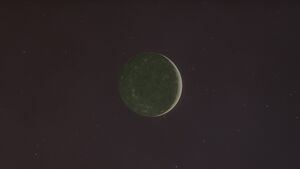Kurato
Jump to navigation
Jump to search
| Orbital characteristics | |||||||||||||
|---|---|---|---|---|---|---|---|---|---|---|---|---|---|
| Epoch A2000 | |||||||||||||
| Aphelion | 244410 km (151870 mi) | ||||||||||||
| Perihelion | 219360 km (136300 mi) | ||||||||||||
| 231887 km (144088 mi) | |||||||||||||
| Eccentricity | ~0.054021 | ||||||||||||
| 13.4711 d (323.31 h) | |||||||||||||
Average orbital speed | 1.249 km/s (0.776 mi/s) | ||||||||||||
| Inclination | 10.3670° (to Stratos's equator) 1.3524° (to the ecliptic) | ||||||||||||
| Satellite of | Stratos | ||||||||||||
| Physical characteristics | |||||||||||||
Equatorial radius | 1124.0 km (698.4 mi) | ||||||||||||
Polar radius | 1123.2 km (697.9 mi) | ||||||||||||
| Flattening | ~.0006441 | ||||||||||||
| Circumference | 7059.787 km (4386.748 mi) (mean) | ||||||||||||
| 15,865,000km2 (6,125,000 mi2) | |||||||||||||
| Volume | 5.94188 × 109 km3 | ||||||||||||
| Mass | 2.2812 × 1022 kg | ||||||||||||
Mean density | 3.8392 g/cm3 | ||||||||||||
| 1.2059 m/s2 | |||||||||||||
| 1.646 km/s (1.023 mi/s) | |||||||||||||
Sidereal rotation period | synchronous | ||||||||||||
| 2.02° | |||||||||||||
| Albedo | 0.234 Bond | ||||||||||||
| |||||||||||||
| 0.55524° (From Stratoshian surface) | |||||||||||||
Kurato, or Stratos II, is the larger of the two significant moons of Stratos, with an orbital period of just shorter than 13 and a half days around the planet.
Formation
WIP
Physical Characteristics
WIP
Surface Geology
WIP
Orbit and Rotation
Kurato is tidally locked to Stratos, similar to that of Loftuslo, and completes an orbit around the planet about every 13.5 days. Curiously, the moon has a relatively large axial tilt for a tidally locked moon, even moreso than the Moon, making for slight variations in which portions of the moon's surface can be seen on the Stratoshian surface.
Habitability
WIP


